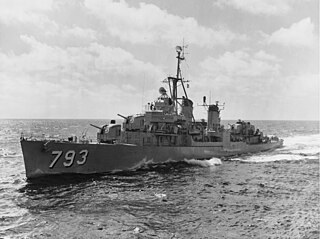
USS Belleau Wood was a United States Navy Independence-class light aircraft carrier active during World War II in the Pacific Theater from 1943 to 1945. The ship also served in the First Indochina War under French Navy temporary service as Bois Belleau.

USS Cabot (CVL-28/AVT-3) was an Independence-class light aircraft carrier in the United States Navy, the second ship to carry the name. Cabot was commissioned in 1943 and served until 1947. She was recommissioned as a training carrier from 1948 to 1955. From 1967 to 1989, she served in Spain as Dédalo. After attempts to preserve her failed, she was scrapped in 2002.

USS Mobile (CL-63) was a Cleveland-class light cruiser of the United States Navy. She was the third ship named for Mobile, Alabama.

USS Minneapolis (CL/CA-36) was a New Orleans-class cruiser built for the United States Navy before the outbreak of World War II, the second ship named for Minneapolis, Minnesota. She served in the Pacific Theater during World War II.

The second USS San Diego (CL-53) was an Atlanta-class light cruiser of the United States Navy, commissioned just after the US entry into World War II, and active throughout the Pacific theater. Armed with 16 5 in (127 mm)/38 cal DP anti-aircraft guns and 16 Bofors 40 mm AA guns, the Atlanta-class cruisers had one of the heaviest anti-aircraft broadsides of any warship of World War II.

USS Franks (DD-554), a World War II-era Fletcher-class destroyer in the service of the United States Navy, was named after Medal of Honor recipient Acting Master's Mate William Joseph Franks.

USS Miller (DD-535) was a World War II-era Fletcher-class destroyer in the service of the United States Navy, named after Medal of Honor recipient Acting Master's Mate James Miller.

USS Ralph Talbot (DD-390) was a Bagley-class destroyer in the United States Navy, named for USMC Second Lieutenant Ralph Talbot (1897–1918), who was awarded the Medal of Honor during World War I. Talbot served in the Pacific Theater during World War II, from the attack on Pearl Harbor through the battle of Okinawa, earning 14 battle stars for her service.

USS Cassin Young (DD-793) is a Fletcher-class destroyer of the U.S. Navy named for Captain Cassin Young (1894–1942), who was awarded the Medal of Honor for his heroism at the Japanese attack on Pearl Harbor and killed in the Naval Battle of Guadalcanal in the fall of 1942.

USS Owen (DD-536), was a Fletcher-class destroyer of the United States Navy.

USS Callaghan (DD-792), a Fletcher-class destroyer, was a ship of the United States Navy named for Rear Admiral Daniel J. Callaghan (1890–1942), who was killed in action in the Naval Battle of Guadalcanal and posthumously awarded the Medal of Honor for heroism during the action.

USS Stockham (DD-683), a Fletcher-class destroyer, was a ship of the United States Navy named for Medal of Honor recipient Gy.Sgt. Fred W. Stockham, USMC (1881–1918).

The first USS Dewey (DD-349) was a Farragut-class destroyer of the United States Navy, launched in 1934 and named for Admiral George Dewey. Dewey served in the Pacific through World War II. After escaping damage during the attack on Pearl Harbor, Dewey screened the aircraft carrier USS Lexington until the carrier was lost in the battle of the Coral Sea; then screened USS Saratoga through the invasion of Guadalcanal and the battle of the Eastern Solomons. Following overhaul in San Francisco, Dewey spent 1943 in Alaskan waters supporting the invasions of Attu and Kiska. Dewey spent 1944 supporting raids in the Marshalls, Carolines, and Marianas, including screening carriers during the battle of the Philippine Sea. After being damaged by Typhoon Cobra during the recapture of the Philippines, Dewey supported the invasion of Iwo Jima and spent the remainder of the war screening replenishment oilers.

USS Prichett (DD-561), was a Fletcher-class destroyer of the United States Navy.

USS Dortch (DD-670) was a Fletcher-class destroyer of the United States Navy.

USS Conner (DD-582) was a Fletcher-class destroyer of the United States Navy, the second Navy ship to be named in honor of Commodore David Conner (1792–1856), who led U.S. Naval forces during the first part of the Mexican–American War.

USS Cotten (DD-669) was a Fletcher-class destroyer of the United States Navy, named for Captain Lyman A. Cotten (1874–1926).

USS Porterfield (DD-682) was a Fletcher-class destroyer of the United States Navy. She was laid down by the Bethlehem Shipbuilding, San Pedro, California 12 December 1942; launched 13 June 1943; sponsored by Mrs Louis B. Porterfield and commissioned 30 October 1943, with Commander J. C. Woefel in command.

The second USS McCall (DD-400) was a Gridley-class destroyer in the United States Navy named after Captain Edward McCall, an officer in the United States Navy during the War of 1812. Launched in 1937, she saw service throughout World War II, including in the Guadalcanal Campaign, Battle of the Philippine Sea, and other battles, earning 9 battle stars for her service. She was struck from the rolls in 1947 scrapped the following year.

The second USS Maury (DD-401) was a Gridley-class destroyer in the United States Navy. She was named for Matthew Maury.






















